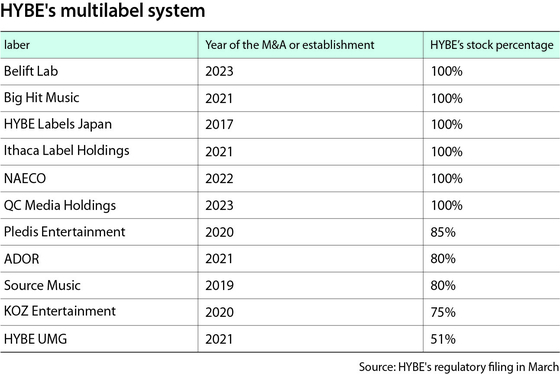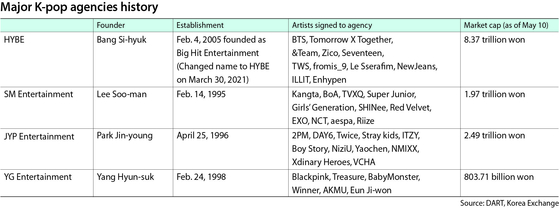Quantifying the unquantifiable: K-pop's obsession with numbers is killing the industry
![HYBE's Bang Si-hyuk, left, and ADOR CEO Min Hee-jin [HYBE, ADOR]](https://koreajoongangdaily.joins.com/data/photo/2024/05/12/c78a7fff-419f-4e86-90c7-e4f6b00470c4.jpg)
HYBE's Bang Si-hyuk, left, and ADOR CEO Min Hee-jin [HYBE, ADOR]
[FIRST IN A THREE-PART SERIES]
HYBE CEO Bang Si-hyuk alerted the world with a shocking revelation in March 2023: “K-pop is in crisis.” The analysis, it turned out, came after witnessing firsthand the crises within his own company and the subsidiaries under its giant HYBE umbrella.
The ongoing bloodshed between the BTS agency and its subsidiary ADOR, home to girl group NewJeans, has brought up issues inherent to the K-pop industry that have previously been overlooked or treated as unfixable elephants in the room.
In this three-part series, the Korea JoongAng Daily will dive deeply into the ails of the K-pop industry that the ongoing feud between HYBE and the CEO of ADOR has uncovered and the changes that must follow.
How big is K-pop? That question — and ensuing efforts to answer it by describing a cultural phenomenon with numbers alone — may be the kryptonite that's been slowly killing the genre.
Of the countless reasons that experts suggest are behind the HYBE-ADOR brawl, one of the most cited is the industry's obsession with “success” and the urge to prove that success with figures. Whether it be the number of albums sold, the size of a concert's audience or the price of the company’s shares, K-pop promotion has long centered largely — if not entirely — on the quantifiable metrics associated with musicians and their work, rather than on music itself.
Inevitable though it may be in a capitalist world, the compulsion to fatten numbers has led to reckless expansion without solidifying the foundations upon which the industry was built, experts say.
Hasty mergers, a theocratic management structure wherein a music producer becomes the company's chairman and the absence of endeavors to truly understand musical culture have added up to a critical moment in K-pop — a defining point that could wake the industry up to a better future.
The multiedged, multilabel sword
HYBE's self-applauded multilabel system has turned out to be a well-sharpened double-edged sword. The structure, in itself, wasn't a problem for HYBE — but the company's hasty and disorderly approach to it was.

The multilabel approach of Big Hit Entertainment, as HYBE was known before it changed its name in 2021, began in July 2019 when the company bought Source Music, the agency behind now-disbanded girl group GFriend, followed by Seventeen's Pledis Entertainment in May 2020. In 2018, Big Hit co-founded the label Belift Lab, in collaboration with Mnet, to debut a boy band.
The rationale behind the aggressive expansion was clear: The more successful products were folded in HYBE's portfolio, the easier it would be for the company to convince investors of its worthiness to be listed on the stock exchange.
Acquiring labels with unique characteristics to diversify an artistic portfolio is a strategy that Hollywood's “Big Three” record companies — Universal Music Group, Sony Music and Warner Music Group — have employed since the 1960s.
![Belift Lab's ILLIT [BELIFT LAB]](https://koreajoongangdaily.joins.com/data/photo/2024/05/12/65acf25c-7315-4ea1-8909-03e971e711d1.jpg)
Belift Lab's ILLIT [BELIFT LAB]
![ADOR's NewJeans [ADOR]](https://koreajoongangdaily.joins.com/data/photo/2024/05/12/c81dc0b1-e480-4498-af12-4066cf7c7969.jpg)
ADOR's NewJeans [ADOR]
Korean entertainment firms, on the other hand, entered the global scene relatively recently, and HYBE is the only K-pop agency among the “Big Four”— which also includes SM Entertainment, YG Entertainment and JYP Entertainment — to adopt such a multilabel system.
As of 2024, HYBE is a K-pop powerhouse with 11 labels under its belt. Its iconic K-pop acts, including such household names as BTS, NewJeans, Le Sserafim, Seventeen and Tomorrow X Together, have made waves in the global music scene.
“The core of the HYBE-ADOR conflict lies not in the multilabel system itself, but in how all labels exist in a ‘vertical’ structure under HYBE while maintaining their exclusivity,” said Lee Dong-yeun, a professor at Korea National University of Arts.
“The labels lack cooperation with each other and maintain each of their territories when it comes to their own content. And although HYBE doesn’t seem forceful when it comes to the content creation of each of the labels, it still does hold legal rights over the labels that make it impossible for them to break free.”
ADOR CEO Min Hee-jin's argument that Belift Lab had copied her label's girl group, New Jeans, speaks to the apparent lack of collaboration and chemistry among HYBE's sprawling roster of artists. At minimum, HYBE has neither achieved the coherence or unity that can be seen among the teams under JYP Entertainment and SM Entertainment nor succeeded in keeping its subsidiaries fully independent from each other as Kakao Entertainment and RBW have.
That problem isn’t unique to HYBE, said a former music composer who spoke on the condition of anonymity.
“A commonality among K-pop agencies is an excessive focus on results, over-competitive atmosphere and inability to break away from the singular category of ‘idol music,’” he said, using the Korean term “idol” to refer to celebrities in the K-pop industry.
“The purpose of a multilabel system is to strengthen each label’s brand so that it can reach out to a wide range of consumers with diverse genres of music. However, all of HYBE’s 11 labels overlap in their target demographics, and the company has chosen to pursue only one genre of music because it’s what brings in the cash. Obviously, it’s not a structure that allows for musical diversity.”
The multitasking nightmare
While HYBE may be overly diversified, the K-pop industry, ironically, also suffers from the opposite problem: Its companies don't separate management from content production.
As evidenced by the HYBE-ADOR spat, it's common for K-pop producers to handle both the business and the artistic sides of their labels. Examples include ADOR's Min, HYBE’s Bang Si-hyuk, JYP Entertainment’s Park Jin-young, YG Entertainment’s Yang Hyun-suk and SM Entertainment’s Lee Soo-man — though the latter was ousted from his company last year.
![Pledis Entertainment's Seventeen [PLEDIS ENTERTAINMENT]](https://koreajoongangdaily.joins.com/data/photo/2024/05/12/76a8cb9c-2240-4ae7-946f-406b5678fd84.jpg)
Pledis Entertainment's Seventeen [PLEDIS ENTERTAINMENT]
“I wear the hats of both a producer and president,” Min said in an interview with Fast Company last November.
“In most cases, people separate the creative side and the business side. But I thought that the two things had to be together in order to be perfect. I believe that great creativity has to be accompanied by a business [grounding] because you have to be commercially successful for good designs and good creativity to spread.”
Such drives for perfection among producer-slash-CEO-slash-musicians have likely bolstered the success of NewJeans and other popular artists, but they've also contributed to the industry's current complex mess, which encompasses both content and business.
Min's dual accusations, both that ILLIT had copied her intellectual property as a producer and that her contract with HYBE as CEO of ADOR was unfair, led to a cluttered entanglement of labor, management and content production reminiscent of SM Entertainment's management brawl that took place last year.
![BigHit Music's Tomorrow X Together [NEWS1]](https://koreajoongangdaily.joins.com/data/photo/2024/05/12/85f3603b-92f3-481a-b27e-6a98e23d175f.jpg)
BigHit Music's Tomorrow X Together [NEWS1]
Failure to separate creators from managers also complicates relationships between artists and producers, which are often likened to those of family members. Min is widely known as NewJeans’ mother, Bang as BTS's father and Lee Soo-man as the teacher to SM Entertainment artists, making K-pop battles a whole lot messier.
“The artist management system, or nurturing methods, have been hailed as success stories achieved by the individual who founded the company from his experience as a producer,” said Professor Lee Jong-im of Seoul National University of Science & Technology.
“Their methods soon became entrenched as ‘the’ management style for agencies. This results in a system centered around individual success and personal preferences rather than the establishment of systematic governance equipped for risk management and label operation.”

Numbers, numbers, numbers
And the deadliest poison of all: fussing over numbers. Critics have often explained that K-pop is not a genre of music but an industry and its structure — a perception that may be at the heart of the dysfunctional episodes playing out to this day.
K-pop is a music industry at its core, but the objective quality of K-pop songs is rarely discussed compared to their numeric success on music charts or their impact on the stock market. Even when such songs are nominated for major music awards, arguments over whether they deserve the honors tend to be grounded in the volume of YouTube views or online streams they have accumulated, rather than the quality or innovative aspects of their music.
“The way we’ve assessed K-pop so far has been focused on ‘what’ it has done and achieved, almost like we’re addicted to miracles,” said journalist-turned-music-critic Lim Hee-yun.
“The first miracle was when BTS landed the highest place of the Billboard 200 albums chart in 2016 for a K-pop group, and it’s been a streak of miracles that has almost become ‘normal.’ Yes, companies had to prove themselves to investors with tangible results, but it’s only been aggravating everyone in the industry when outsiders fuss over the slightest fall in numbers and act like it’s the end of the world.”
![Source Music's Le Sserafim [SOURCE MUSIC]](https://koreajoongangdaily.joins.com/data/photo/2024/05/12/610dd6a1-070e-4acb-a533-5e05f91c0f06.jpg)
Source Music's Le Sserafim [SOURCE MUSIC]
When boy band Stray Kids sold 4.6 million copies of its album “5-Star” within a week of release last year in June, headlines declared that K-pop had managed to accomplish something no other music industry in the world had. But when that first-week sales figure fell to 3.7 million for “Rock-Star” in November, the same publications foretold a crisis for K-pop — a reckoning that HYBE’s Bang had predicted earlier that year.
“Such an unhealthy cycle has been taking place in K-pop for almost three decades now,” Lim said. “This pressure to keep up the upward growth trajectory has become nothing but an obsession. This is reality. It’s a myth, and the problems in reality are arising because of this adhesion to myth.”
There is but one solution, experts say, and that is to take it slow: to take a step back from the million-selling myth and the chart-slaying saga.
“At the end of the day, K-pop is a genre of culture — at the heart of it lies the music, the emotions of the people that are in the industry and the sentiments of the consumers and the onlookers,” Professor Lee said.
“The longer this conflict proceeds, the more damage will be done to NewJeans and every other artist in the HYBE label. An amicable solution may seem far away, but it’s really the only way that this situation won’t end up in a lose-lose situation. Bang and Min need to sit down, talk about their differences and they — as well as every other insider of the industry — need to think about the changes that need to come forth to make sure that K-pop becomes a sustainable industry.”
BY YOON SO-YEON, LEE JAE-LIM [yoon.soyeon@joongang.co.kr]










with the Korea JoongAng Daily
To write comments, please log in to one of the accounts.
Standards Board Policy (0/250자)